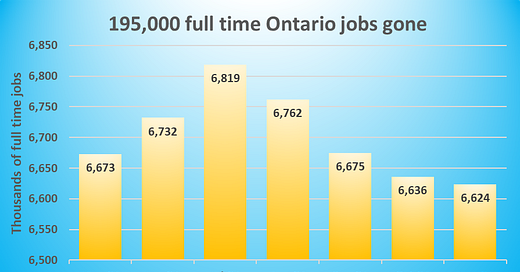Ontario full-time jobs continue fall, now 195,000 below peak, says StatsCan report
While other provinces have improving or stable job pictures, Ontario's jobless rate last month spiked fastest in Canada, says today's StatsCan report.
While the rest of Canada appears to be heading for a soft landing, signals continue to flash that Ontario is in a crash, hammered between a big auto sector down-turn and its on-going housing and affordability crisis.
The roiling Ontario economic crisis continued to kill full time jobs in November as the seasonally adjusted jobless rate rose 0.8 points to 7.6 per cent, the biggest jump of any province, according to Statistics Canada’s Labour Force Survey released this morning.
The unemployment rate in five provinces fell while rising slighting in Alberta (+0.2), Quebec (+0.2) and New Brunswick (+0.1). Unemployment dropped to 5.6 per cent in Saskatchewan (-0.4), 5.7 per cent in British Columbia (-0.1) and 5.8 per cent in Manitoba (-0.1).
195,000 full time jobs disappear in past four months
Another 10,000 full-time Ontario jobs vanished in November, continuing a four month trend. In November there were 195,000 fewer full-time jobs than four months before.
Ontario’s part-time employment continued its recent upward trend, and is now 60,000 ahead of November 2023.
Even on a seasonally adjust basis, jobs last month fell in construction, utilities, manufacturing, trucking and warehousing, and finance, insurance, real estate, rental and leasing.
Manufacturing takes big job loss, despite promises
Since its most recent peak in June, 44,000 Ontario manufacturing jobs have disappeared. Ontario now has 27,000 fewer manufacturing jobs than in June 2018, when the Doug Ford PC government was elected on a “guarantee” to create 300,000 new manufacturing jobs.
The province’s auto and auto parts industry is recently down, adding to longer term trends. Major production in Oshawa, St. Catharines, London and Windsor has permanently closed. Ford’s Oakville plant remains idle. The company in April cancelled a plan to build an electric vehicle at the plant, and now plans to restart with F-Series Super Duty production, but not until 2026.
At 8.7 per cent, Canada’s auto capital of Windsor had the highest unemployment rate of any major city in the country.
A US industry report released today projects Canada will produce 1.3 million vehicles in 2024, down from over two million in 2018. Dozens of Ontario parts plants have gone idle.
A spring 2024 report by Unifor, the union with the largest representation of auto industry workers, has said the industry’s problem is “a crisis borne of government neglect” that has been building for many years.
Toronto housing crisis ripping though economy
Toronto’s seasonally adjusted unemployment rate reached 8.1 per cent in November, and with renters and mortgage holders facing high household costs, the consumer will not be riding to the rescue.
Across the country about two million mortgage holders face higher monthly payments in 2025 and 2026, with the impact epicentre being the Greater Toronto Area, where housing inflated fastest and borrowing grew quickly.
The housing market peak came as the Bank of Canada hiked interest rates to fight inflation, which had the side-effect of bursting the highly leveraged and overpriced housing market in the Greater Toronto Area.
Toronto had a 34 per cent increase in housing prices in the 12 months before the start of interest rate hikes, according to Canadian Real Estate Association data. Rents rose in tandem as the PC government lagged other provinces in housing starts.
With the high cost of living in the Greater Toronto Area is putting a pinch on consumers, Ontario’s retail sales remains slumped below a February 2022 peak, though they are at record highs in the rest of Canada. Personal bankruptcy is rising fastest in Ontario.





The job market is brutal around the GTA. Rentals around North York are around $3300 for some condos and some mortgages are around $3000 even after large down payments.